Car Trims 101: What Is a Car Trim?
March 14, 2023
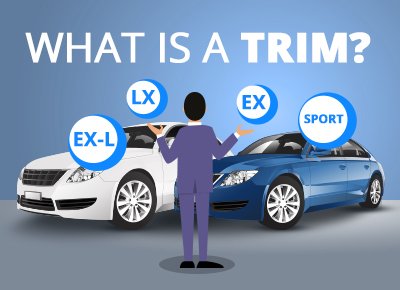
I am a serial entrepreneur and a consumer advocate. When I’m not helping car buyers, I love working on ventures that have a positive impact. I run a cause marketing agency and serve on the board of Vayu Global Health where we are disrupting the medical industry and preventing the needless deaths of mothers and babies during childbirth.
So you’ve painstakingly researched cars and finally decided what model you want. But guess what, now you have another decision, what trim to buy!
Manufacturers often create different versions of every vehicle model they produce, and each one is called a trim.
Table of Contents
- So What Is A Car Trim?
- Definition of a Trim Level
- Why Are Trim Levels Used?
- Understanding Trim Level Naming Conventions
- Example Trim Levels
- What Are Options?
- What Are Accessories Packages?
- What Are the Make and Model?
- What Are Body Styles?
- Making an Informed Decision
- Best Car Deals by Category
- Frequently Asked Questions
So What Is A Car Trim?
A car trim, also known as a trim level or configuration package, refers to different versions or variations of a specific vehicle model produced by manufacturers.
Each trim level is equipped with a distinct set of features, and the higher the trim level, the more features it typically offers, accompanied by a higher price tag. Trim levels are denoted by names or alphanumeric codes, often displayed on the rear of the vehicle, and they help identify the specific features and equipment included in the car.
Car trims play a crucial role in allowing buyers to customize their vehicles according to their preferences and needs. The trim level determines various aspects of the car, including the engine type, interior upholstery, exterior features, available equipment, transmission type, and wheel and tire size.
Manufacturers use naming conventions such as letters, acronyms, or words to represent trim levels, often reflecting the level of luxury, sportiness, or performance associated with a particular trim.
Definition of a Trim Level
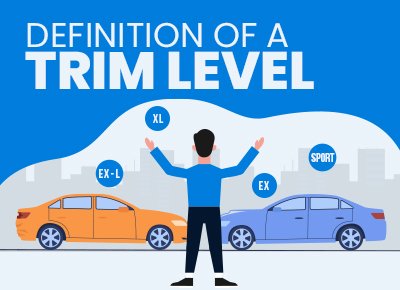 A trim level (or configuration package) is a version of a vehicle model that is equipped with a distinct set of features. The higher the trim level of a model, the more features and the higher the price tag. Each higher trim level will typically add upon the features of the entry-level model (typically called the "base" model) or replace them with better variations.
A trim level (or configuration package) is a version of a vehicle model that is equipped with a distinct set of features. The higher the trim level of a model, the more features and the higher the price tag. Each higher trim level will typically add upon the features of the entry-level model (typically called the "base" model) or replace them with better variations.
Manufacturers assign a name for each trim level, usually 2 or 3 letters shown after the model, such as Ford Ranger XL. The trim level is often displayed on the rear of the vehicle.
Why Are Trim Levels Used?
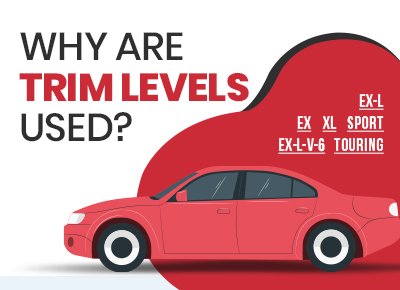 Car trims help you identify the manufacturer-installed features of the vehicle you’re buying.
Car trims help you identify the manufacturer-installed features of the vehicle you’re buying.
Your car’s trim often dictates:
- Engine type
- Interior upholstery
- Exterior features
- Available equipment
- Transmission type
- Wheel size and tire size
Understanding Trim Level Naming Conventions
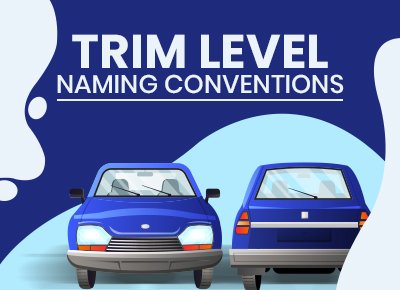
Trim levels are named using a pair of letters such as SL or GT, alphanumeric codes such as Z28 or XR5, or words such as Executive or Ambition.
Most letter combinations symbolize a trim’s origins, such as SL and GT which stand for Standard Level and Gran Turismo, respectively.
The acronyms and trim level names used will vary greatly between manufacturers. Below we show the most popular and widely used trim level names and what they mean:
Base & Mid-level Trim Naming Convention
The most common way manufacturers denote the standard trim level for a model is with "base". Here are some widely used base level naming conventions and their meaning:
- L - Entry Level Grade
- S - Standard
- SL - Standard Level
- EX - Extra
- SV - Standard Value
- SXT - Standard Extra Trim
- SLE - Special Level Extra
Sport & Performance Trim Naming Convention
Most manufacturers separate their sport and performance-based trims by naming them "sport" or "turbo". Some other common names used are:
- GT - Gran Turismo
- GTS - Gran Turismo Sport
- RS - Rally Sport
- RST - Rally Sport Truck
- SR - Sport Rally
- SRT - Street and Racing Technology
- LS - Luxury Sport
- SE - Sport Edition
- SX - Sport Crossover
- SV - Special Version
- XSE - Extreme Sport Edition
- XL - Extra Load
- TRD - Toyota Racing Development
Luxury Trim Naming Convention
Some of the more popular ways manufacturers denote their high-end or luxury trims is with names like "Platinum", "Premium", "Reserve", or "Touring". Some other standard naming conventions include:
- ES - Executive Sedan
- EX-L - Extra Luxury
- LE - Luxury Edition
- LT - Luxury Touring
- LX - Luxury
- LTX - Luxury Touring Special
- LTD - Limited
- SEL - Special Edition Limited
- SLT - Special Luxury Touring
- XLE - Executive Luxury Edition
- XLT - Extra Luxurious Truck / Extra Level Touring
- Editions (ex. Black Label or 80th Anniversary)
Example Trim Levels
For you to better understand car trim levels, here’s what the 2021 Hyundai Tucson trim levels are like:
- SE: The Hyundai Tucson SE trim is the entry-level model. It comes with a 2.0-liter four-cylinder engine. Like all the other trims of this model, it has a six-speed automatic gearbox and a front-wheel-drive system. It has automatic halogen headlights and 17-inch alloy wheels. Inside, there’s a six-way manual driver’s seat and cloth upholstery. Its infotainment contains a seven-inch touchscreen display with a six-speaker sound system.
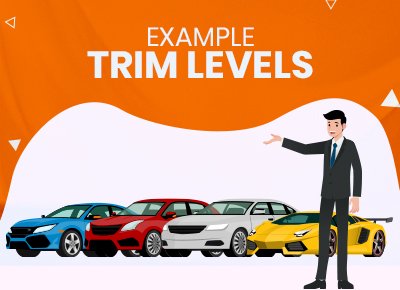 Value: The Value trim level adds eight-way power adjustability to the driver seat, with heating on both front seats. It expands the safety suite with a blind-spot monitor with rear cross-traffic alert.
Value: The Value trim level adds eight-way power adjustability to the driver seat, with heating on both front seats. It expands the safety suite with a blind-spot monitor with rear cross-traffic alert.- SEL: The SEL trim level adds 18-inch wheels, dual-zone automatic climate control, and rear air conditioning to its portfolio and is the first trim level that has a bigger engine.
- Sport: The 2021 Hyundai Tucson Sport offers many upgrades from the SEL trim level, including 19-inch alloy wheels, LED headlights, taillights, and daytime running lights, a hands-free power liftgate, leather interior details, and wireless charging.
- Limited: The Limited level boasts of heating functionality and leather seating. The car provides a 360-degree camera, and the passenger seat has power adjustability.
- Ultimate: The top-of-the-line 2021 Hyundai Tucson Ultimate provides ventilation for the front seats and heating on the rear seats. The infotainment contains an eight-inch system with built-in navigation. It also has high-beam assist, smart cruise control, pedestrian detection, and a panoramic sunroof.
As you can see, the higher the trim level is, the more unique built-in details a car has. It’s important to understand car trim levels because, as shown in the example, there are more considerations in buying a 2021 Hyundai Tucson than its color, transmission, and style. There are six trim levels to choose from, each offering a unique detail that you might enjoy.
What Are Options?
In addition to various trim levels, car manufacturers may also offer options to give you more choices. An option is a single add-on component that you can add to your car, usually for an extra cost.
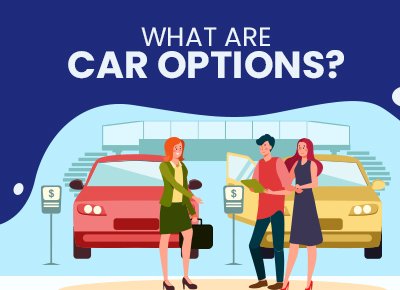 Options and packages are different from car trims in such a way that they usually bundle fewer additional features. Car trims offer a wider slate of supplementary equipment. Automakers will sometimes only allow particular options for specific trim levels, and these options will not be available for lower levels. We’ll discuss packages in more detail later.
Options and packages are different from car trims in such a way that they usually bundle fewer additional features. Car trims offer a wider slate of supplementary equipment. Automakers will sometimes only allow particular options for specific trim levels, and these options will not be available for lower levels. We’ll discuss packages in more detail later.
There are dozens of options available for you, from aesthetic additions to those that can improve your car’s safety. Here are some examples of car options you can purchase:
- Upgraded stereo
- Larger engine
- Sunroof
- Adjustable pedals
- Leather seats
In the example earlier, you may purchase the 2021 Hyundai Tucson SE but opt for heating for the front seats, which the Value trim level offers.
What Are Accessories Packages?
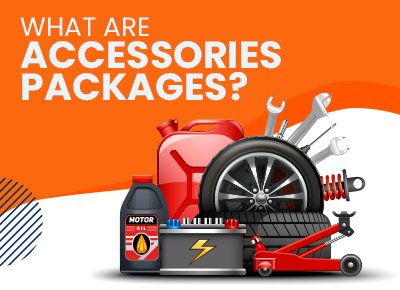 An accessory package is a group of aesthetic or functional options that manufacturers bundled to meet specific consumer needs. Brands create packages to make related options more affordable.
An accessory package is a group of aesthetic or functional options that manufacturers bundled to meet specific consumer needs. Brands create packages to make related options more affordable.
Each manufacturer offers unique packages, but here are seven common ones and some of their inclusions:
1. Appearance package
- Paint Job
- Tint Job
- Interior pieces
- Exterior decals
- Roof covers
2. Performance package
- Engine upgrades
- Handling upgrades
- Brake upgrades
- Rear Spoilers
- Tie downs
3. Sports package
- Recaro sports seats
- Larger wheels
- Upgraded tires
- Upgraded steering wheels
- Paddle shifters
4. Towing package
- Heavy-duty radiator
- Engine cooling
- Transmission cooling
- Larger cooling fans
- Revised axle gearing
5. Safety package
- Adaptive Cruise Control (ACC)
- Automatic Emergency Braking (AEB)
- Additional airbags
- Adaptive headlights
- Blindspot detection
6. Handling package
- Adaptive suspension
- Stiffer springs
- Stiffer shock absorbers
- Active steering system
- Anti-roll bars
7. Navigation package
- Satellite navigation
- Bigger display screen
- Upgraded stereo system
- Stronger signal
- Theft resistance
Compute the costs and check if it’s more reasonable for you to get select options or a complete package.
What Are the Make and Model?
The make is the manufacturer’s brand. The model is the specific vehicle name or range of vehicles.
Take Toyota for example. Toyota is the “make”, and there are several different models. RAV4 is a type of Toyota, but so is a Camry. So, Toyota RAV4 and Toyota Camry have the same make but are different models.
What Are Body Styles?
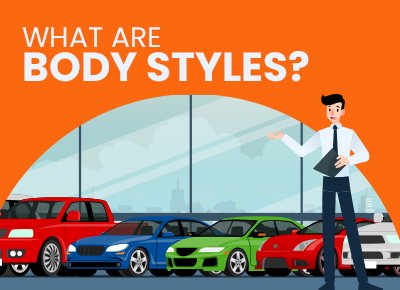 Manufacturers usually offer different body style options for specific car models, which should not be mistaken for car trims. Two cars can have the same trim but different styles. For example, you may purchase the Honda Civic in either sedan or hatchback.
Manufacturers usually offer different body style options for specific car models, which should not be mistaken for car trims. Two cars can have the same trim but different styles. For example, you may purchase the Honda Civic in either sedan or hatchback.
Here are some of the most common body styles:
- Convertible
- Coupe
- Hatchback
- Sedan
- SUV
- Wagon
- Minivan
Making an Informed Decision
Now that you know the answer to the commonly-asked question, “What is a car trim?” you can make an informed decision before buying a car. It’s best to have a definitive list of the features you want to have so you can find the perfect combination of car trims, options, and packages that will give you the best value for your money.
Best Car Deals by Category
Frequently Asked Questions
Why do cars have trim levels?
Having trim levels allows manufacturers to meet the ever-changing demand of their consumers. Using trim levels target different needs and different budgets.
Are entry-level cars worth it?
If you’ve done your research on a particular brand and model and you’re satisfied with the specs of its entry-level trim, then go ahead and purchase it. The higher levels are available for buyers with specific preferences and usually with a bigger budget, but the same manufacturer made both trims. They were most likely built by the same people and went through the same quality control testing.
Is it better to purchase a more expensive model with a low trim or a less expensive model with a high trim?
The answer to this question is dependent on which options you want for your car. List down your non-negotiables and compare prices. Different brands and sellers have different option prices, but the answer should be the car that gives you more savings.
How do I know the trim of my vehicle?
Your original sales invoice or owner’s manual usually contains this information. Some cars also have decals or emblems stating their trim. If you still can’t find your car’s trim using these methods, you may visit the manufacturer’s website and use your vehicle identification number (VIN) to get trim information.
Posted in Car Buying Tips |




